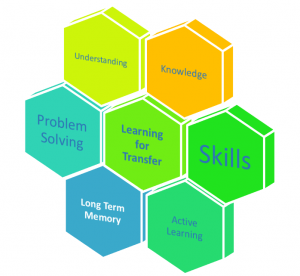Backwards Planning Professional Development for 1:1
I love the Understanding by Design (UbD) method for planning learning with the end in mind. This makes perfect sense, no matter what you teach – if your goal is to make sure that your students learn. (it’s not enough to say you “taught” it.) In my case, my learners happen to be teachers, and so modeling backwards planning when designing professional learning is essential.
 Currently, I am working on a plan for professional learning to support teachers who may pilot 1:1 through BYOD “Bring Your Own Device” in their classes next year. In UbD, Stage 1 involves identifying the learning goals for transfer, understanding, knowledge, and skills, and an overarching essential question that can drive the learning. I love how thinking through these learning goals can spark ideas for the “performance assessment” – which in this case will be the teachers designing learning that is focused on learning goals, and then designing a performance assessment and activities to support those goals – which is where the technology comes into play.
Currently, I am working on a plan for professional learning to support teachers who may pilot 1:1 through BYOD “Bring Your Own Device” in their classes next year. In UbD, Stage 1 involves identifying the learning goals for transfer, understanding, knowledge, and skills, and an overarching essential question that can drive the learning. I love how thinking through these learning goals can spark ideas for the “performance assessment” – which in this case will be the teachers designing learning that is focused on learning goals, and then designing a performance assessment and activities to support those goals – which is where the technology comes into play.
Here are the goals I’ve drafted–what would you add?
Transfer Goal:
Teachers create learning ecosystems that motivate students to own the learning by using technology to support deeper, more personal learning.
Goals for Understanding:
- What is possible to do with technology that could not be done without it
- Understanding how to design learning that motivates learners to take ownership
- Understanding how to give learners voice and choice
- Understand that learning is a social endeavor
- Understand that learner questions and questioning are at the heart of learning
- Understand that real world problem solving motivates learners to reach higher
- Understand that the more they release control, the more students will own the learning
Goals for Knowledge
- Teachers know how to backwards design learning
- Know what it “looks like’ when students are using technology in transformative ways
- Teachers know how to design learning for authentic problem solving
- Teachers know the 21st century skills
- Teachers know how to facilitate, rather than just deliver learning
Goals for Skill
- Basic troubleshooting of devices
- How to use a core group of apps and tools for creating and connecting
- How to model, teach, assess and give students feedback on 21st century skills
Essential Question: How can we make the learning ecosystem meaningful for each individual learner?
Nancy, Thanks for sharing your ideas. These goals will be helpful to the teachers I work with as they forge ahead to plan 1:1 implementation in their district. One of their big concerns is that teachers do not feel familiar enough with Common Core Standards to plan instruction that produces the test results they desperately need to achieve accreditation and/or re-accreditation.
What goals would you suggest around this concern?



First, I think these goals are brilliant. In particular, I think these goals are some of the best that I have seen for PD:
1. What is possible to do with technology that could not be done without it
2. Understand that learner questions and questioning are at the heart of learning
3. Know what it “looks like’ when students are using technology in transformative ways
The ones that I struggle with are when you get into jargon like “voice and choice” or “21st Century Skills”. I struggle with putting goals in front of folks that do not communicate the specific outcomes you are looking because the terms get in the way. With that said, I think you mostly have described a session/initiative that I would very much like to attend. The only things I would add would be about how students become a community of learners or how they can capture their learning and reflect upon within a process of inquiry and through a portfolio.
Again, thank you for laying this out so succinctly. P.S. This comment is a part of the #C4C15 project. Find out more here: http://learningischange.com/blog/2014/12/27/c4c15/